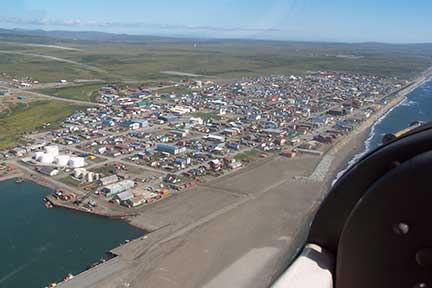Visiting an Eskimo Village
August 5, 1986
We found ourselves near the Eskimo village of Shishmaref and decided to stop in for a visit. The village is located on a sandy island between a lagoon and the Chukchi Sea. We could see pack ice just north of the lagoon, and the Siberian mainland far in the distance.
Right after we landed, a three-wheeler with a trailer pulled up. The driver found out we needed fuel and offered to take us to Walter's store. We climbed into the trailer with her three children, stout Eskimo boys aged 2 to 5.
Walter was not at the store, but someone else helped Dennis get gas into the plane while I waited at the store and talked with Josie, a young clerk. She said the pack ice is usually gone by the end of June, but this year it's late. The hunters were still taking walrus and bearded seal.
Later, as we walked through town down the narrow dirt street, we saw children playing everywhere. An old umiak was upside down, the walrus hide rotting. There were sealskins, caribou hides, and sealskin floats made by turning the skin of the animal inside out and inflating it.
We left the village and continued down the beach toward log racks with dark meat hanging in the sun to dry. The logs must have floated from far away, as there are no trees within a hundred miles or more.
We came upon a group of women working hard—cutting meat and stripping blubber two inches thick off a hide. They used ulus, a traditional Eskimo knife. One smiled and we asked if we could come closer and watch.
The old woman worked quickly and expertly, cutting meat into hunks which she said they would store inside sealskins underground. She was teaching her daughters how to cut the blubber from the skin, being careful to remove extra oil. They cut it into chunks, which are allowed to ferment before being eaten. A little boy chewed on some dried jerky.
The liver had been boiled and was drying. They let me try a small piece and it was excellent, the best liver I've tasted!
 After a while, we wandered on down the beach. A polar bear hide hung from a rack. Shishmaref is known as the "polar bear capital of the world." We saw one rack with drying seal meat. The carcass of a dead seagull hung by the neck from a rope, to scare away birds we were told. There weren't any gulls around, and more surprisingly, there weren't any bugs. The Eskimos would rather endure fierce winter winds than mosquitoes, so they build their villages near the sea in places totally exposed to the Arctic weather.
After a while, we wandered on down the beach. A polar bear hide hung from a rack. Shishmaref is known as the "polar bear capital of the world." We saw one rack with drying seal meat. The carcass of a dead seagull hung by the neck from a rope, to scare away birds we were told. There weren't any gulls around, and more surprisingly, there weren't any bugs. The Eskimos would rather endure fierce winter winds than mosquitoes, so they build their villages near the sea in places totally exposed to the Arctic weather.
I asked the women if the village hunts whales and they said no. Nevertheless, we found a pile of whale ribs on the beach.
Since the schoolteachers were gone for the summer, we were the only white people in town. Everyone was genuinely friendly and the doors to all the houses were standing open. It seems they have no reason to distrust one another.
We visited the cemetery on the hill, filled with white crosses and wreaths of plastic flowers. Many of the people had died between the ages of 80 and 90. I could only imagine the changes they must have seen during their lives. When they were young, all of their people lived a subsistence lifestyle.
We returned to the airplane and took off toward the ocean, circling over the icebergs and waving our wings at the women still butchering seal below.
Note: The photo of Shishmaref above was taken some years later, after erosion of the beach line became a serious problem. The other photo is of an Eskimo woman in Anchorage during Fur Rendezvous.
Go on to read Katmai National Park
Source: www.SusanCAnthony.com, ©Susan C. Anthony

